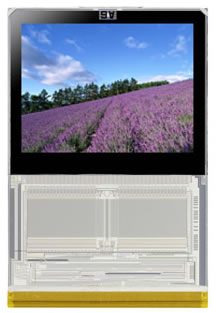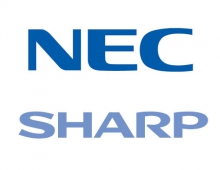
NEC LCD Color TFT LCD Module With DRAM Embedded Onto Glass Substrate
NEC LCD Technologies today announced development of the world's first thin-film-transistor (TFT) liquid crystal display (LCD) prototype module with a DRAM frame memory system, corresponding to 1 8-bit color (262k colors), embedded onto the glass substrate of the LCD screen.
The new LCD module has been realized by a combination of NEC LCD Technologies' TFT-LCD (VIT) technology and low-temperature poly-silicon (LTPS) TFT technology.
The company designed a system LSI onto the glass substrate of the screen, utilizing a record-breaking 400,000 transistors in the peripheral circuits. The LCD integrates the peripheral circuits, including the frame memory system that incorporates a 230k-bit DRAM and a front-end picture decoder, a picture encoder, 6-bit DAC, and a controller.
NEC's proprietary graphical data compression / decompression technology, smart pixel-data codec (SPC), enables a reduction in the amount of memory required to store the data of one screen image by two thirds that required by original data that doesn't employ any kind of codec, thereby contributing to a reduction in circuit area and power consumption.

In addition, the doption of a RGB horizontal stripe for the pixel arrangement enables high density, a polychrome display, and optimization of cell layout of the graphics frame memory, simultaneously. This kind of pixel arrangement enables greater minimization of the circuit area on the glass substrate.
A newly-developed controller enables simultaneous and independent access for writing and reading in graphics frame memory, and achieves a data transfer rate of approximately 30 frames per second.
The display can be used in portable devices, such as personal digital assistants (PDAs), personal navigation devices (PNDs), smartphones and portable multimedia players (PMPs).
Currently, graphics frame memory is realized by a COG-mounting method that attaches system-LSI chips, made on a silicon substrate, directly onto the glass substrate of the LCD. However, this poses a problem for timely manufacturing of new LCD modules as the lead time for mass production of system LSI chips is very long.
"The market is already eagerly awaiting the advancement of system-on-glass LCDs as they will eliminate the need to develop LSI chips, thereby shortening development cycles significantly, and allowing us to bring the right products to our customers and the markets faster than ever before," said Hideki Asada, Senior Manager of Research Department at NEC LCD Technologies. "Embedding the frame memory onto the glass substrate is a completely new breakthrough in system-on-glass LCD technology, and will enable significant reductions in display power consumption."
The results of NEC's research will be presented on May 24 at SID 2007, being held at the Long Beach Convention Center in California from May 20 to 25.
The company designed a system LSI onto the glass substrate of the screen, utilizing a record-breaking 400,000 transistors in the peripheral circuits. The LCD integrates the peripheral circuits, including the frame memory system that incorporates a 230k-bit DRAM and a front-end picture decoder, a picture encoder, 6-bit DAC, and a controller.
NEC's proprietary graphical data compression / decompression technology, smart pixel-data codec (SPC), enables a reduction in the amount of memory required to store the data of one screen image by two thirds that required by original data that doesn't employ any kind of codec, thereby contributing to a reduction in circuit area and power consumption.

In addition, the doption of a RGB horizontal stripe for the pixel arrangement enables high density, a polychrome display, and optimization of cell layout of the graphics frame memory, simultaneously. This kind of pixel arrangement enables greater minimization of the circuit area on the glass substrate.
A newly-developed controller enables simultaneous and independent access for writing and reading in graphics frame memory, and achieves a data transfer rate of approximately 30 frames per second.
The display can be used in portable devices, such as personal digital assistants (PDAs), personal navigation devices (PNDs), smartphones and portable multimedia players (PMPs).
Currently, graphics frame memory is realized by a COG-mounting method that attaches system-LSI chips, made on a silicon substrate, directly onto the glass substrate of the LCD. However, this poses a problem for timely manufacturing of new LCD modules as the lead time for mass production of system LSI chips is very long.
"The market is already eagerly awaiting the advancement of system-on-glass LCDs as they will eliminate the need to develop LSI chips, thereby shortening development cycles significantly, and allowing us to bring the right products to our customers and the markets faster than ever before," said Hideki Asada, Senior Manager of Research Department at NEC LCD Technologies. "Embedding the frame memory onto the glass substrate is a completely new breakthrough in system-on-glass LCD technology, and will enable significant reductions in display power consumption."
The results of NEC's research will be presented on May 24 at SID 2007, being held at the Long Beach Convention Center in California from May 20 to 25.

















